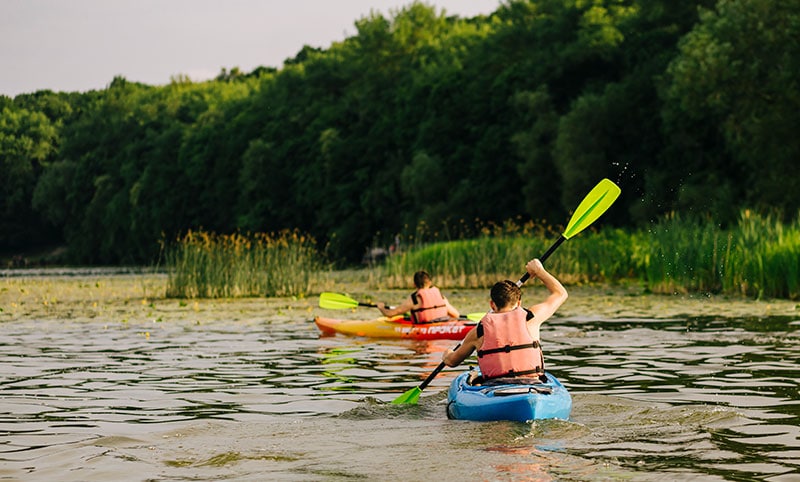If you are just getting started in kayaking, you need to acquire a few basic skills early on.
These skills are so basic and so obvious that you may not even think you need to learn them.
That is, until you actually need them.
What You Should Know

Here are a few of the basic things that a beginner will need to learn:
1. How to Lift and Carry a Kayak
Two-Person Method :If you are only carrying your kayak a short distance, use an underhand lift.
You do this by standing and on the opposite side and end of the boat from your partner.
You will each grab the nearest carrying toggle and lift the kayak with your backs straight and your knees bent.
Solo Method: It is also possible to lift and carry a kayak on your own.
Note that even if you have trouble the first couple of times, you will soon build enough arm strength and stamina to do it on your own.
A shorter, lighter boat can be lifted onto one shoulder.
Rest the kayak on the ground against your shins with the cockpit facing away from you.
Hold onto the cockpit rim closest to your chest and lift the boat to thigh level with your left hand.
Reach in with your right hand, grab the opposite side of the rim and bring that up to shoulder level.
Position the boat so that it feels comfortable to carry.
If you are able to get it well balanced, you will be able to carry your kayak without either end hitting the ground.
2. How to Load Kayak onto a Vehicle
Two-Person Method: If you are using straps, lay them out on your vehicle beforehand.
Place the kayak to one side of the vehicle and lift it overhead until it is just over the roof rack, then let it down gently.
Solo Method: Loading a kayak onto a vehicle without help can be challenging; however, the job can be made simpler if your vehicle has a strong roof rack.
Read: How To Put A Kayak On A Roof Rack By Yourself
If your vehicle has a factory rack, you can get special accessories that are designed to fit them.
Basic towers are usually able to support more weight when compared to factory racks, you may want to invest in them depending on the rack system you plan on using.
If your kayak saddle has rolling wheels, set the bow into the rear cradle.
Next, lift the stern and roll the kayak forward into the front cradle.
There are also lift systems available that will take the hard work out of the process.
Related: Will A Kayak Fit Inside My Car?
3. How to Get Into and Out of a Kayak
Until you are actually sitting in your seat, a kayak is a particularly skittish and untrustworthy vessel.
If you are used to canoeing, you may be tempted to enter a kayak in much the same way.
If you do, you are most likely going for a swim. So what is the right way to do it?
One way is to float your kayak into shallow water and place one blade of your paddle across the rear deck, just behind the rim of the cockpit.
The other blade should go flat on the shore.
Next, squat next the kayak and grab the paddle shaft with one hand and the cockpit rim with the other.
Place one leg into the cockpit and then when your body is over the seat, bring the other leg in.
This approach to getting works for both new paddlers and old alike.
You can also get into your kayak while on land and simply push your way into the water.
All you need is some level ground near the water. Make sure to keep your paddle on your deck or in your other hand as you do this.
To get out, simply follow these steps in reverse.
READ: How To Get Into A Kayak From The Water
4. How to Store a Kayak
Because sunlight can degrade most of the materials used to construct hulls, it is best to store your kayak indoors if at all possible.
If this is not an option, do your best to find a shaded spot in your yard.
A weather resistant tarp is a good option for protecting your boat from sunlight.
However, note that it is best to suspend your tarp above the hull.
If it rests on the hull, this can provide the perfect environment for mold and fungi to flourish if there is moisture present.
Also, be careful to keep snow and rain from collecting in the tarp to the extent that they weigh down on the hull as this can deform it.
If you have an inflatable kayak, keep it disassembled indoors when storing it for extended periods.
Extended exposure to rain and snow can damage the fabrics used for inflatable kayaks.
Additionally, if you paddle in salt water, rinse your boat before storing it as salt water can corrode some metal components.
RELATED: Best Kayaks for Beginners
